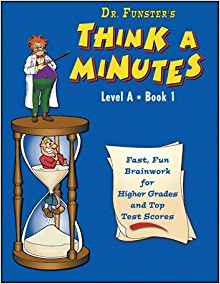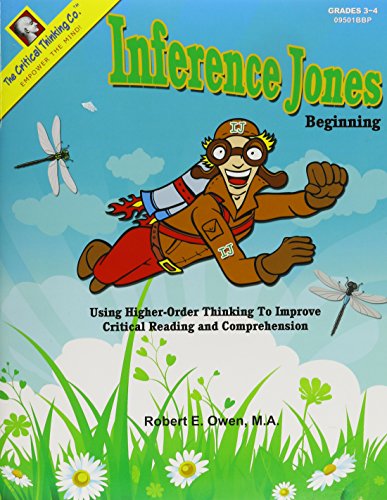-
Dr. Funster's Think-A-Minutes A1 - Fast, Fun Brainwork for Higher Grades & Top Test Scores
None
Paperback (Critical Thinking, Jan. 2, 2002)This 48-page book is a collection of our most popular quick, fun thinking puzzles. The wide variety of activities in each book develop reading comprehension, vocabulary, and mathematical reasoning as well as writing, spatial, and visual perceptual skills. They also build deductive, inductive (inferential), and creative thinking skills. The puzzles are perfect for school, home, and travel. They are very popular as brain-start, extra credit, sponge, or reward activities. Each book includes easy-to-follow directions and answers. Try one and you'll be hooked!
-
Jumbles: Prefixes, Suffixes, Compound Words, Grades 3-5
Noreen Conte
Paperback (The Critical Thinking, Aug. 16, 2013)This fun, engaging 80-page book teaches prefixes, suffixes, and new vocabulary. Each lesson includes activities where the student chooses the correct vocabulary word used in context, identifies the prefix or suffix, and solves a jumble puzzle that reinforces the lesson. The jumble puzzle is the punchline to a joke or riddle that is solved by unscrambling a set of words related to the one page lesson. In order to solve the jumble, students must first unscramble a set of vocabulary words related to the lesson. Each unscrambled word is a clue to the answer of the joke or riddle. The final step of the jumble puzzle is to look for multiple word meanings, synonyms, homographs, homophones, idioms, or figurative language to identify the answer to the joke or riddle. Students LOVE jumbles and each jumble reinforces the lesson. Try a sample (above) and you'll be hooked! A complete answer key is included.
-
Mathematical Reasoning Level E - Bridging the Gap Between Computation and Math Reasoning
Carolyn Anderson
Paperback (The Critical Thinking Co., Jan. 1, 2010)Forget boring math lessons and dreaded drill sheets. This fun, colorful 384-page book that is geared for 4th graders uses engaging lessons with easy-to-follow explanations, examples, and charts to make fourth grade mathematical concepts easy to understand. It can be used as a textbook or a comprehensive workbook with your textbook to teach the math skills and concepts that students are expected to know in fourth grade--and several concepts normally taught in fifth grade. This book emphasizes problem-solving and computation to build for success in higher-level math and math assessments.Every lesson is followed with a variety of fun, colorful activities to ensure concept mastery. The lessons and activities spiral slowly, allowing students to become comfortable with concepts, but also challenging them to continue building their problem-solving skills. This book teaches more than mathematical concepts; it teaches mathematical reasoning, so students learn to devise different strategies to solve a wide variety of math problems. It is written to the standards of the National Council of Teachers of Mathematics. CONTENTS: Addends, Addition, Age, Analyze Data, Angles, Area, Bar Graph, Calendar, Capacity, Characteristics, Circle Graphs, Coins, Congruence, Coordinates, Count, Data Analysis, Data Collection, Decimals, Division, Equations, Equivalence, Estimate, Fractions, Graphs, Inequalities, Language, Length, Match, Mean, Median / Mode, Money, Multiplication, Negative Numbers, Number Lines, Odd/Even, Order, Parallel, Patterns, Perimeter, Perpendicular, Place Value, Prediction, Prime/composite, Probability, Properties, Real World Problems, Reflection/Translation/Rotation, Regrouping, Rounding, Rulers, Shapes, Subtraction, Survey, Symmetry, Tables, Temperatu
-
Mind Benders - Verbal: Deductive Thinking Skills, Grades K-2 by Harnadek, Anita Paperback
None
Paperback (Critical Thinking, )None
-
Practical Critical Thinking: Teacher's Manual - Problem-Solving, Reasoning, Logic, Arguments
Catherine Connors-Nelson, Teens - Reference
Paperback (The Critical Thinking Co., Aug. 16, 2015)This detailed 304-page Teacher's Manual is highly recommended to be used with Practical Critical Thinking: Student Book, engaging students in the study of critical thinking. This book lays a strong foundation in the important cognitive skills necessary for critical thinking, such as comprehension, analysis, evaluation, construction, creativity, and communication. Through fun and concrete activities–including Thought Experiments, Student Polls, Practice Sessions, Games and Puzzles, Predictions, and Important Takeaways–students explore topics essential to critical thinking, gaining tools that will help them apply critical thinking directly to their own lives. Additional individual and group activities are included to reinforce student learning as they explore topics such as: • The Basics of Critical Thinking • Obstacles to Critical Thinking • Evaluating Evidence • Creative Problem-Solving • Ambiguity, Vagueness, and Doublespeak • Arguments • Informal Fallacies • Advertising • Eyewitness Testimony, Direct & Circumstantial Evidence
-
Reading Detective Rx
Cheryl Block, Christine Broz, Margaret Hockett, Dave White, Susan Giacometti
Paperback (The Critical Thinking Co., Jan. 1, 2002)(Grades 6-12+)The standards-based critical thinking activities of Reading Detective® develop the analysis, synthesis, and vocabulary skills students need for exceptional reading comprehension. The activities are especially effective at helping students understand more challenging reading concepts such as drawing inferences, making conclusions, determining cause-and-effect, and using context clues to define vocabulary.Students read and analyze short literature passages and stories that include fiction and nonfiction genres. Then they answer multiple-choice and short-response questions, citing sentence evidence to support their answers. The Grades 6–12+ remedial (Rx) level is organized into single-skill units with a concluding mixed-skills unit and provides an introductory lesson for each skill. (Rx activities are "prescriptive" to help underperforming students in Grades 6–12+ improve their comprehension skills. Reading level is Grades 4–6; story content is Grades 6+.)Teaching SupportIncludes pretests, post-tests, lesson guidelines, and answers with detailed evidence. Reading and literary analysis skills are based on grade-level standards.
-
Balance Benders: Logic and Algebraic Reasoning Puzzles, Level 3
Robert Femiano, Teens - Reference
Paperback (The Critical Thinking Co., Aug. 16, 2010)Move over Sudoku, here come Balance Benders™! You can use these books as quick, fun logic problems or as stepping stones to success in algebra. Children develop deductive thinking and pre-algebra skills as they solve balance puzzles that are more fun and addictive than Sudoku puzzles! Children must analyze each balance to identify the clues, and then synthesize the information to solve the puzzle. Try one -- and then try to stop!
-
The Critical Thinking Word Roots Level 4 School Workbook
Cherie A. Plant, Teens - Reference
Paperback (The Critical Thinking Co., Aug. 16, 2015)Students learn the meaning and spelling of roots, prefixes, and suffixes commonly used in English. Learning these word elements dramatically improves spelling and the ability to decode unfamiliar words. The activities focus on using these words in context to help students incorporate each word into their vocabulary and retain the correct spelling. There are periodic reviews to make sure students retain what is taught in the lessons. Word Roots books will add hundreds of words to your students' vocabulary and greater depth to their thinking and writing.
-
Inference Jones Beginning Workbook - Using Higher-Order Thinking to Improve Critical Reading and Comprehension
Robert E. Owen, Susan Penfield, Catherine Connors-Nelson
Paperback (The Critical Thinking, Oct. 1, 2012)This 48-page book provides short, fun, and easy-to-use reading comprehension activities that improve critical reading and higher-order thinking skills. The activities focus on developing the student's ability to draw inferences from written text as they identify and evaluate evidence. Questions following all stories teach students to evaluate details that at first seemed insignificant but are actually meaningful! These activities develop a depth of analysis that guarantees superior inferential and reading comprehension skills for top grades and higher test scores! Research shows inferential reasoning is a prerequisite component to superior reading comprehension. The National Foundation for Educational Research concluded that "the ability to draw inferences predetermines reading skills: that is, poor inferential reasoning causes poor comprehension and not vice versa." We all make inferences in our daily lives (e.g. we naturally think a child is happy because we see them laughing). But how does this ability apply to written communication? When we read a written passage, we're actually reading a representation of the author's thoughts and ideas, because the written word does not convey a meaning in and of itself. Readers must construct the meaning through interpretation. The reader's interpretation is the result of inferential analysis which includes drawing from personal knowledge and experiences, social values, and cultural conventions. The interpretation connects a meaning to the words, providing the reader with an understanding of the character's actions, circumstances, or events in the story. Inference Jones Beginning includes zany, amusing, and clever short stories full of hints and clues to help students hone their inference skills. It has a readability level appropriate for Grades 3-4 but can also be used as a remedial resource for older students (Grades 5-12+).
-
Kindergarten Thinking Skills & Key Concepts
Sanda Parks, Howard Black
Paperback (The Critical Thinking Co., Aug. 16, 2015)This highly-effective, standards-based, 160-page book is a research-based instructional program that teaches beyond most state and Common Core standards by: • Improving children's observation and description skills • Developing academic vocabulary • Developing thinking skills that underlie content learning (describing/defining, identifying similarities and differences, sequencing, and classifying) • Improving students' understanding of key concepts in mathematics, social studies, and science • Students completing structured exercises to write sentences and paragraphs • Carefully sequencing lessons to develop thinking skills • Employing language integration techniques to teach thinking skills and key conceptsThe program builds academic vocabulary using these important concepts: describe, compare and contrast, and classify colors, geometric shapes, family members, food, jobs, vehicles, buildings, and position.This student book can be used with a detailed, 176-page Teacher's Manual which can be purchased separately. The Teacher's Manual provides instructions to teach the lessons using research-proven methods that promote students' thinking: direct instruction, cooperative learning, whole sentence responding, and language integration activities.
-
Vocabulary Virtuoso: Elementary School Vocabulary for Academic Success
Nancy Forderer
Paperback (The Critical Thinking Co., Aug. 16, 2016)This 176-page book uses fifteen lessons to teach 150 words that fourth and fifth grade students should know for reading, writing, and standardized tests. Each lesson includes a story involving elementary school students that introduces language arts concepts such as homonyms, homophones, homographs, key words, antonyms, hyperbole, fables, myths, folk tales, and speech writing. Additional stories focus on the branches of government and the constitution, scientific method and formulating a hypothesis, and the Revolutionary War.Each lesson contains definitions, pronunciation keys, parts of speech, and alternate choices for each word made up of synonyms, idioms, and/or phrases. There are several activities, including a story involving students in a classroom setting.Students complete a variety of exercises requiring critical reading and writing skills to contextualize the words. The exercises deliberately use other forms of the words as different parts of speech, so that students learn to recognize these forms as variations of the original words— further expanding their vocabulary and enabling them to use the words in more contexts. The correct spelling of vocabulary words are emphasized with the jumble activity that asks students to unscramble the word before writing the correct spelling.Whether used in the traditional classroom, as a homeschooling resource, or for independent study, Vocabulary Virtuoso is a highly effective and fun vocabulary resource!Elementary Level - 150 Vocabulary Words and These Concepts:homonyms, homophones, homographs, hypothesis, key words, antonyms, hyperbole, fables, myths, folk tales, essay and speech writing
-
You Decide!: Applying the Bill of Rights to Real Cases: Grades 6-12+
George Bundy Smith, Alene Smith
Paperback (The Critical Thinking Co., Aug. 16, 1992)This highly recommended 144-page teacher's guide is used with the You Decide! student book–sold separately–to teach students about the Bill of Rights. This guide includes objectives, suggestions, and a graphic organizer to keep track of facts in each case and the Supreme Court decisions. Because the student book does not contain the court decisions, use of the guide is essential.Students acquire an in depth understanding of the Bill of Rights by: • Learning each of the first 8 amendments to the U.S. Constitution. • Reading real court cases involving each amendment. • Judging each case based on their knowledge of the relevant amendment and the facts of the case. • Comparing their ruling with the ruling of the U.S. Supreme Court.